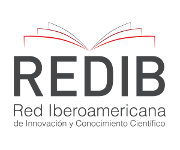
Published
Determining the Effect of Photovoltaic Module Surface Temperature on Generation Efficiency
Determinación del efecto de la temperatura superficial de los módulos fotovoltaicos en su eficiencia de generación
DOI:
https://doi.org/10.15446/ing.investig.106383Keywords:
solar PV-T module, PV surface temperature, PV efficiency (en)módulo solar PV-T, temperatura superficial PV, eficiencia PV (es)
Downloads
It is imperative to consider the environmental impact of energy production and its cost in deciding how to meet future energy needs. In this regard, it is possible to harness the power of the sun by using photovoltaic (PV) cells. However, when the temperature of a PV cell increases, its generation efficiency is negatively affected. The open-circuit voltage of PV modules is the most sensitive parameter to temperature changes. As the temperature rises, this parameter decreases, and the short-circuit current increases. The circuit's resistance also rises as the electrons’ speed is reduced. Temperature also affects the lifespan of PV cells, increasing the rate of thermal decay in their materials. On the other hand, when solar radiation is absorbed at lower temperatures, the system’s efficiency, power capacity, and useful life increase. PV module surface temperatures can be reduced in a variety of ways, e.g., the surface can be cooled using water. This work studied hybrid PV-thermal modules under the climate conditions of the Hatay province (Turkey) in order to assess the effect of water cooling on their generation efficiency. The results allow stating that up to 52.6% more electricity can be generated by cooling the module's surface. Additionally, it was found that, in order for PV modules to perform efficiently in Hatay's climate, they must operate at a maximum surface temperature of 55 °C.
Es imperativo considerar el impacto ambiental de la producción de energía y su costo al decidir cómo satisfacer las necesidades energéticas futuras. A este respecto, es posible aprovechar el poder del sol utilizando células fotovoltaicas (PV). Sin embargo, cuando la temperatura de una célula PV aumenta, su eficiencia de generación se ve negativamente afectada. El voltaje en circuito abierto de los módulos PV es el parámetro más sensible a los cambios de temperatura. A medida que la temperatura aumenta, este parámetro disminuye, y la corriente de cortocircuito aumenta. La resistencia del circuito también se eleva a medida que la velocidad de los electrones se reduce. La temperatura también afecta la vida útil de las células PV, incrementando la tasa de degradación térmica en sus materiales. Por otro lado, cuando la radiación solar se absorbe a temperaturas más bajas, la eficiencia del sistema, la capacidad de potencia y la vida útil aumentan. Las temperaturas superficiales de los módulos PV pueden reducirse de varias maneras, e.g., la superficie puede enfriarse utilizando agua. Este trabajo estudió módulos híbridos PV-térmicos bajo las condiciones climáticas de la provincia de Hatay (Turquía) con el fin de evaluar el efecto del enfriamiento con agua en su eficiencia de generación. Los resultados permiten afirmar que se puede generar hasta un 52.6 % más de electricidad enfriando la superficie del módulo. Además, se encontró que, para que los módulos PV funcionen eficientemente en el clima de Hatay, deben operar a una temperatura superficial máxima de 55 °C.
References
Abu-Rahmeh, T. M. (2017). Efficiency of photovoltaic modules using different cooling methods: A comparative study. Jour-nal of Power and Energy Engineering, 5, 32-45. https://doi.org/10.4236/jpee.2017.59003
Agyekum, E. B, PraveenKumar, S., Alwan, N. T., Velkin, V. I., and Shcheklein, S. E. (2021). Effect of dual surface cooling of solar photovoltaic panel on the efficiency of the module: experimental investigation. Heliyon, 7(9), e07920, https://doi.org/10.1016/j.heliyon.2021.e07920
Akbarzadeh, A., and Wadowski, T. (1996). Heat-pipe-based cooling systems for photovoltaic cells under concentrated solar radiation. Applied Thermal Engineering, 16(1), 81-87. https://doi.org/10.1016/1359-4311(95)00012-3
Andreev, V. M., Grilikhes, V. A., and Rumyantev V. D. (1997). Photovoltaic conversion of concentrated sunlight. Wiley.
Dubey, S., Sarvaiya, J. N., and Seshadri, B. (2013). Tempera-ture dependent photovoltaic (PV) efficiency and its effect on PV production in the world: A review. Energy Procedia, 33, 311-321. http://doi.org/10.1016/j.egypro.2013.05.072
Govardhanan, M. S., Kumaraguruparan, G., Kameswari, M., Saravanan, R., Vivar, M., and Srithar, K. (2020). Photovoltaic module with uniform water flow on top surface. International Journal of Photoenergy, 2020, 9. https://doi.org/10.1155/2020/8473253
Gül, M., and Akyüz, E. (2019). Performance investigation of a hybrid photovoltaic-thermal (PV/T) system. Journal of Balıkesir University Institute of Science and Technology, 21(1), 444-458. http://doi.org/10.25092/baunfbed.548728
Haidara, Z. A., Orfib, J., and Kaneesamkandi, Z. (2018). Exper-imental investigation of evaporative cooling for enhancing photovoltaic panels efficiency. Results in Physics, 11, 690-697 https://doi.org/10.1016/j.rinp.2018.10.016
Luboń, W., Pełka, G., Janowski, M., Pająk, L., Stefaniuk, M., Kotyza, J., and Reczek, P. (2020). Assessing the impact of water cooling on PV modules efficiency. Energies, 13(10), 2414. https://doi.org/10.3390/en13102414
Meinshausen, M., Meinshausen, N., Hare, W., Raper, S. C. B., Frieler, K., Knutti, R., Frame, D. J., and Allen, M. R. (2009). Greenhouse-gas emission targets for limiting global warming to 2 °C. Nature, 458, 1158-1163. http://doi.org/10.1038/nature08017
Peng, Z., Herfatmanesh, M. R., and Liu, Y. (2017). Cooled solar PV panels for output energy efficiency optimisation. Energy Conversion and Management, 150, 949-955. https://doi.org/10.1016/j.enconman.2017.07.007
Radziemska, E. (2003). The effect of temperature on the power drop in crystalline silicon solar cells. Renewable Energy, 28, 1-12. https://doi.org/10.1016/S0960-1481(02)00015-0
Rawat, P., and Dhiran, T. S. (2017). Comparative analysis of solar photovoltaic thermal (PVT) water and solar photovolta-ic thermal (PVT) air systems. International Journal of Civil, Mechanical and Energy Science, 3(1), 8-12. https://www.researchgate.net/publication/315657756_Comparative_Analysis_of_Solar_Photovoltaic_Thermal_PVT_Water_and_Solar_Photovoltaic_Thermal_PVT_Air_Systems
Shalaby, S. M., Elfakharany, M. K., Moharram, B. M., and Abosheiasha, H. F. (2022). Experimental study on the perfor-mance of PV with water cooling. Energy Reports, 8(Supp. 1), 957-961. https://doi.org/10.1016/j.egyr.2021.11.155
Shukla, A., Kanta, K., Sharmaa, S., and Biwoleb, P. H. (2017). Cooling methodologies of photovoltaic module for enhanc-ing electrical efficiency: A review. Solar Energy Materials & Solar Cells, 160, 275-286. https://doi.org/10.1016/j.solmat.2016.10.047.
Solimpeks (n.d.) Product Catalogue. https://solimpeks.com.tr/wp-content/uploads/14-powerwolt-hibrit.pdf
Teo, H. G., Lee, P. S., and Hawlader, M. N. A. (2012). An active cooling system for photovoltaic modules. Applied Energy, 90, 309-315. https://doi.org/10.1016/j.apenergy.2011.01.017
Tiwari, A., Sodha, M. S., Chandra, A., and Joshi, J. C. (2006). Performance evaluation of photovoltaic thermal solar air collector for composite climate of India. Solar Energy Mate-rials & Solar Cells, 90(2), 175-89. https://doi.org/10.1016/j.solmat.2005.03.002
Wang, G., Chao, Y., and Chen, Z. (2021). Promoting devel-opments of hydrogen powered vehicle and solar PV hydro-gen production in China: A study based on evolutionary game theory method. Energy, 237, 121649. https://doi.org/10.1016/j.energy.2021.121649
Wang, G., Zhang, Z., and Chen, Z. (2023). Design and perfor-mance evaluation of a novel CPV-T system using nano-fluid spectrum filter and with high solar concentrating uniformity. Energy, 267, 126616. https://doi.org/10.1016/j.energy.2023.126616
Zanlorenzi, G., Szejka, A. L., and Canciglieri, O. (2018). Hybrid photovoltaic module for efficiency improvement through an automatic water cooling system: A prototype case study. Journal of Cleaner Production, 196, 535-546. https://doi.org/10.1016/j.jclepro.2018.06.065
Zubeer, S. A., and Ali, O. M. (2022). Experimental and numeri-cal study of low concentration and water-cooling effect on PV module performance. Case Studies in Thermal Engineer-ing, 34, 102007. https://doi.org/10.1016/j.csite.2022.102007
How to Cite
APA
ACM
ACS
ABNT
Chicago
Harvard
IEEE
MLA
Turabian
Vancouver
Download Citation
CrossRef Cited-by
1. Ismail Karali, Ahmet Kabul. (2025). Experimental investigation of using heat pipes and finned heat sink in cooling of PV panels—Thermodynamic and economic analysis consequences. Environmental Progress & Sustainable Energy, https://doi.org/10.1002/ep.70133.
2. Abdelhafid El Ouassidi, Majdouline Alla, Yassine Rharrabi, Kamal Amghar, Hicham Bouali, Ismael Driouch, Bilal El Monhim. (2025). Study of the Impact of Ambient Temperature on the Maximum Temperature Reached by a PV Solar Panel. International Journal of Engineering Research in Africa, 76, p.17. https://doi.org/10.4028/p-S7dJZZ.
3. Anu Mehra, Anubhav Gautam, Kunal Jindal. (2025). Renewable Energy Transition with Artificial Intelligence. , p.139. https://doi.org/10.1002/9781394300068.ch08.
4. Sajarupan Tharumaraja, Madura Prabhani Pitigala Liyanage, Akila Wijethunge, Janaka Ekanayake, Akbo Rupasinghe. (2025). Very Short-Term Surplus Energy Forecasting for Peer-to-Peer Energy Trading in Microgrids. 2025 5th International Conference on Advanced Research in Computing (ICARC). , p.1. https://doi.org/10.1109/ICARC64760.2025.10963019.
Dimensions
PlumX
Article abstract page views
Downloads
License
Copyright (c) 2024 Cengiz Karaca, Seren Yaver

This work is licensed under a Creative Commons Attribution 4.0 International License.
The authors or holders of the copyright for each article hereby confer exclusive, limited and free authorization on the Universidad Nacional de Colombia's journal Ingeniería e Investigación concerning the aforementioned article which, once it has been evaluated and approved, will be submitted for publication, in line with the following items:
1. The version which has been corrected according to the evaluators' suggestions will be remitted and it will be made clear whether the aforementioned article is an unedited document regarding which the rights to be authorized are held and total responsibility will be assumed by the authors for the content of the work being submitted to Ingeniería e Investigación, the Universidad Nacional de Colombia and third-parties;
2. The authorization conferred on the journal will come into force from the date on which it is included in the respective volume and issue of Ingeniería e Investigación in the Open Journal Systems and on the journal's main page (https://revistas.unal.edu.co/index.php/ingeinv), as well as in different databases and indices in which the publication is indexed;
3. The authors authorize the Universidad Nacional de Colombia's journal Ingeniería e Investigación to publish the document in whatever required format (printed, digital, electronic or whatsoever known or yet to be discovered form) and authorize Ingeniería e Investigación to include the work in any indices and/or search engines deemed necessary for promoting its diffusion;
4. The authors accept that such authorization is given free of charge and they, therefore, waive any right to receive remuneration from the publication, distribution, public communication and any use whatsoever referred to in the terms of this authorization.


























